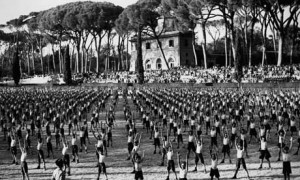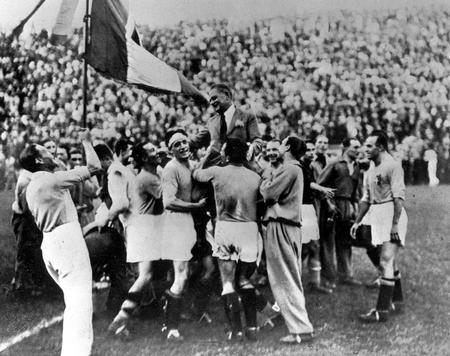Written in 2009 by Emma Anspach, Hilah Almog, and Taylor.
Edited & Updated in 2013 by Brittney Balser and Alessandro Santalbano
***
“The idea that politics and sport should be kept apart is laughable in Italy.”[1]
Benito Mussolini was not the first leader to recognize the political potential of sports, but he placed more emphasis upon them. Bill Murray asserts that, “Mussolini’s Fascist regime was the first to use sports as an integral part of government.”[2] Many of the techniques that Mussolini originated were later imitated by Hitler in Nazi Germany. Stalin, on the other hand, though earlier to utilize sport domestically, was, “unwilling to put the Soviet athletes to the test of international competition until he was sure that they would win.”[3]
In some respects, the usefulness of sport for a Fascist or totalitarian regime is obvious. The values of sport can be used rhetorically to reflect the values of a Fascist regime without much stretching. For example, after Italy’s victory in the World Cup final Il Popolo D’Italia—the newspaper that most directly served as a mouthpiece for Mussolini’s regime—referred to the “vision of harmony, discipline, order, and courage” shown by the national team on the pitch.[4]
Additionally, dominance on the sports field can be extrapolated to a wider context of supremacy. This was most directly seen with Hitler and his Arian athletes at the 1936 Olympic Games, but Mussolini also sought to assert national dominance through sporting achievements. The Italians took special relish in their competitions against political and cultural rivals in Europe such as France, Spain, and England. In 1936 the American sports writer John Tunis asserted that, “An Italian triumph in football, cycling, tennis, or any other sport, particularly if over old rivals like the French, is seized upon, written up and paraded as proof positive of the superiority of the race and its governing principles.”[5]
It is also commonly argued that sport is used by Fascist regimes both as an extension of military training and as an opiate of the masses. Tunis points to both of these motivations for Mussolini and his regime, stating that, “sport becomes just one branch of army training,”[6] and, “It keeps the younger and naturally insurgent elements of the community from thinking too much about internal political conditions and lack of employment.”[7] The Italian Fascists had all of these and more as goals when they set out to both control and nurture the sport domestically with an eye to international competition.
The hand the Fascist regime played in the rapid expansion of organized football in Italy can be seen most concretely in the proliferation of Fascist funded and built football stadiums. “In addition to draining marshes and building roads, the stock in trade of dictatorial regimes, the Fascists built modern soccer stadiums as monuments to their glory.”[8] Stadiums were built throughout Italy.
The “Mussolini” stadium in Turin that hosted the 1933 World University Games, the “Littoriale” in Bologna, the Stadium “della Vittoria” in Bari, the “Berta” in Florence, the “Edda Ciano Mussolini” in Livorno, the “XXVIII Ottobre” in L’Aquila, and the “Citta dello Sport” which opened in Rome in 1932.[9]These stadiums were put forward as a “sign of a fascist will to work and achieve power.”[10]These stadiums served a dual purpose, as they both asserted the industrial might of the fascist regime and helped Italian football grow and flourish, not to mention the fact that it was an essential part of the regime’s push to host the 1934 cup.
The influence of Mussolini on Italian football was felt not just in the physical realm of stadiums, but also at the organizational level. The Fascist regime was prone to directly controlling the administrative bodies of even the smallest elements of Italian society, and football was certainly not immune from this tendency.
The overwhelming success of the Italian national team during the 1930s was overseen by a man by the name of Vittorio Pozzo.[11] Pozzo was “Short, tubby, with black glasses and a shock of bizarre white hair,” and a larger than life persona.[12] Foot suggests, “Pozzo presided over la nazionale as a kind of dictator after the chaos of the initial period.”[13] In this case, the use of the word dictator is not irrelevant, because it was this style of management that made Pozzo seem to some a microcosm of the Fascist government in Italy at large. His unprecedented success during his time in charge of the national team from 1929 until 1948[14]—of eighty eight matches played the Italians won sixty, drew sixteen, and lost only eleven[15]—could be, and often was, viewed as not just a success for Italy, but for the Fascist Regime itself.
Pozzo’s Fascist credentials were apparently validated when, in response to protests during the Italian national anthem at the opening game in Marseille in 1938, “he ordered his team to hold their fascist salute until the anti-fascists in the crowd had stopped whistling.”[16] Yet, this perception of Pozzo as a strong adherent to the Fascist Party line was challenged by evidence that surfaced in the 1990s that he in fact helped the anti-fascist resistance and helped Allied prisoners of war escape during the war. So, perhaps the relationship between Vittorio Pozzo and Mussolini’s regime was more a superficial one. As Foot argues, “Much of the fascist influence on sport—as in Italian everyday life—was symbolic.”[17]
Further Information:
Main Topics:
Football and Politics in Europe
Hitler, Nazi Philosophy, and Sport
Sub-Pages:
How to cite this article: “Football and Politics in Europe, 1930s-1950s” Written by Emma Anspach, Hilah Almog, and Taylor (2009), Edited and Updated by Brittney Balser and Alessandro Santalbano (2013), Soccer Politics Pages, Soccer Politics Blog, Duke University, http://sites.duke.edu/wcwp (accessed on (date)).
[1] John Foot, Calcio: A History of Italian Football (London: First Estate, 2006), 355.
[2] Bill Murray, The World’s Game: A History of Soccer (Chicago: University of Illinois Press, 1996), 65.
[3] Murray, The World’s Game: A History of Soccer, 65.
[4] Gordon, “Italy 1934: Football and Fascism,” 50.
[5] John R. Tunis, “The Dictators Discover Sport,” Foreign Affairs 14, no. 4 (1936): 611.
[6] Tunis, “The Dictators Discover Sport,” 607.
[7] Tunis, “The Dictators Discover Sport,” 607.
[8] Murray, The World’s Game: A History of Soccer, 68.
[9] Angela Teja, “Italian Sport and International Relations Under Fascism,” in Sport and International Politics: The Impact of Fascism and Communism on Sport, ed. Pierre Arnaud and James Riordan (London: E & FN Spoon, 1998): 162.
[10] Teja, “Italian Sport and International Relations Under Fascism,” 162.
[11] Foot, Calcio: A History of Italian Football, 441.
[12] Foot, Calcio: A History of Italian Football, 441.
[13] Foot, Calcio: A History of Italian Football, 441.
[14] Foot, Calcio: A History of Italian Football, 441.
[15] Foot, Calcio: A History of Italian Football, 441.
[16] Foot, Calcio: A History of Italian Football, 442.
[17] Foot, Calcio: A History of Italian Football, 355.



gran entrada
Utterly fascinating!
Food for the thought. As the old adage goes – history repeats itself
Many thanks
Pingback: ฟุตบอลของเผด็จการฟาสซิสต์ | Rhythm & ball
Pingback: ฟุตบอลของเผด็จการฟาสซิสต์ |
Pingback: Fascism & Football: The political history of Spanish football | Scissors Kick
Pingback: Roman Revival — Pro All Stars
Pingback: Roman Revival - PureTennis
Pingback: Travelling Dropout | 10 Football Matches that Changed the World
Pingback: The world’s cuddliest fascist? | in-the-back-of-the.net